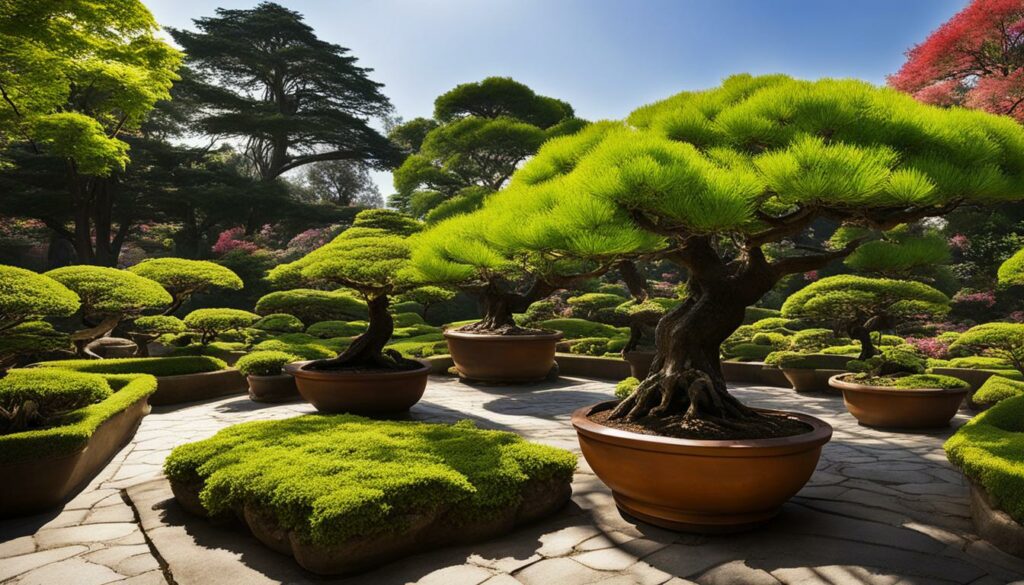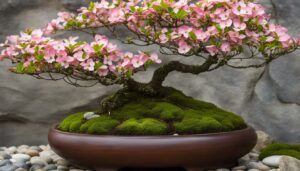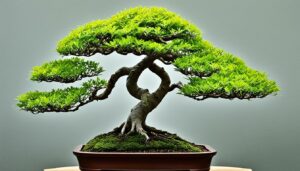Embarking on the journey of nurturing outdoor bonsai species offers a blend of horticultural skill and artistic expression. Moreover, it’s a practice steeped in ancient tradition that continues to captivate garden enthusiasts across the globe. Whether you are enticed by the resilient nature of hardy bonsai trees or the serene elegance they add to your garden landscape, understanding the intricacies of outdoor bonsai is the foundation to cultivating your own living masterpiece.
Outdoor bonsai trees, miniature yet majestic, are not restricted by the walls of an indoor setting, which allows them more freedom to flourish. Garden bonsai thrive under the caress of natural elements, their growth rings telling tales of seasonal changes. The allure of these hardy bonsai trees lies in their ability to withstand the extremes of nature while encapsulating the essence of a full-grown tree within a confined space.
Key Takeaways
- Learn the ancient art of outdoor bonsai to bring a touch of time-honored tradition to your garden.
- Outdoor bonsai species offer a harmonious blend of resilience and beauty for your landscape.
- Discover how garden bonsai connect you to nature through their seasonal growth cycles.
- Uncover the secrets of selecting hardy bonsai trees that will thrive in your unique outdoor environment.
- Embrace the challenge of mimicking the grace of full-size trees within the confines of your outdoor bonsai silhouette.
Discovering the World of Outdoor Bonsai
Outdoor bonsai, the artful practice of shaping miniature trees to emulate mature, full-size specimens, has captured the hearts of garden enthusiasts and nature lovers alike. As a garden bonsai aficionado, you become part of a tradition steeped in history, with roots intertwined with the fabric of diverse cultures across the globe. It’s an ancient horticultural expression of beauty, nature, and patience.
The history of Bonsai Tree Species Outdoor extends beyond mere gardening—it is a profound philosophical journey where each tree tells its own story of resilience, harmony, and balance. Unlike their indoor counterparts, outdoor bonsai offer a symphony of seasonal changes, providing a year-round dynamic landscape in miniature form.
Each outdoor bonsai species holds a universe in the palm of your hand, reflecting nature’s grandeur through its delicate foliage and intricate forms.
Incorporating these living sculptures into your garden isn’t just about adding greenery—it’s about curating a tableau that continues to evolve and inspire. Pines, maples, junipers, and many other species beckon with lush canopies and textured bark, all awaiting their spot in your personal outdoor gallery.
- Pine Bonsai: The quintessential choice for resilience and longevity.
- Juniper Bonsai: Adaptable and perfect for intricate styling.
- Maple Bonsai: Celebrated for vibrant autumnal foliage.
By choosing the right bonsai tree species outdoor for your climate and carefully considering their placement in your garden, these living masterpieces offer not just a visual retreat but also a meditative haven.
Remember
, venturing into the world of garden bonsai is not merely a hobby; it is a continual journey of learning, growth, and creative expression—an enriching pursuit that deepens your connection with the natural world.
Understanding Bonsai Tree Species Outdoor
Delving into the realm of outdoor bonsai species can be a thrilling experience for gardening enthusiasts. The key to success in growing these living artworks lies in selecting hardy bonsai trees that are suited to your climate. Let’s explore some of the most resilient species that excel in outdoor environments.
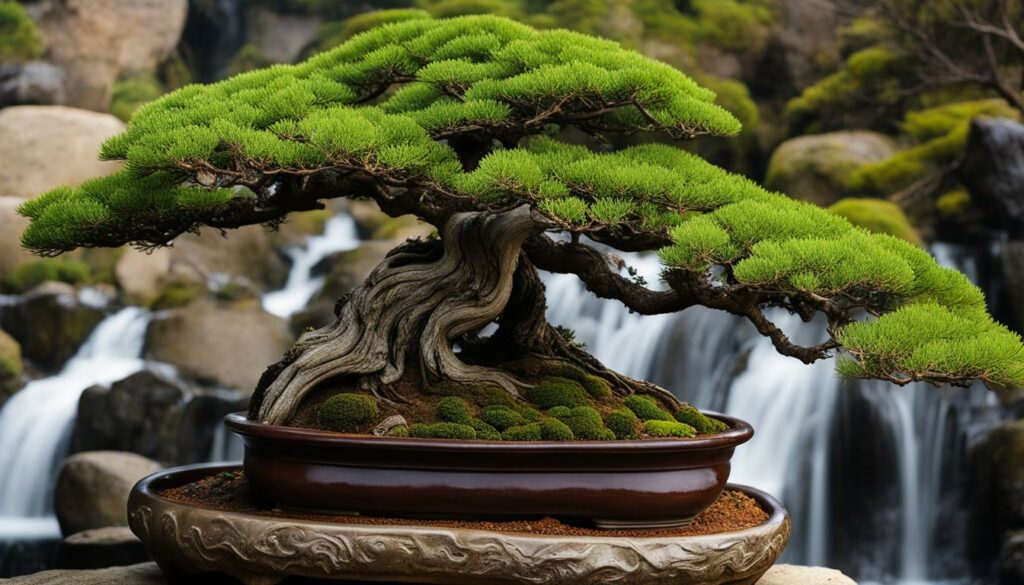
When you’re considering which species to select, it’s essential to understand their tolerance for cold, heat, and humidity. The U.S. Department of Agriculture Plant Hardiness Zone Map is an invaluable tool for matching bonsai trees to your local conditions.
| Species | USDA Hardiness Zones | Notes |
|---|---|---|
| Juniper (Juniperus) | 4-9 | Adaptable and tolerant to a wide range of temperatures, perfect for sculpting. |
| Japanese Maple (Acer palmatum) | 5-9 | Offers stunning foliage color changes, but requires protection from the harshest winters. |
| Pine (Pinus) | 3-8 | Diverse genus with many species exhibiting high resistance to cold. |
| Oak (Quercus) | 5-9 | Symbols of strength, oaks must be given enough space to develop a sturdy structure. |
| Cypress (Cupressus) | 7-10 | Requires more warmth and therefore, more suited to southern regions. |
As showcased, hardy bonsai trees like the Juniper and Pine are highly adaptable and can thrive in many parts of the United States. Conversely, the Japanese Maple and Cypress may need extra attention during extreme temperatures to ensure their survival outdoors.
Remember, successful cultivation of outdoor bonsai species isn’t solely dependent on climate adaptivity. Regular maintenance, adequate watering, and shielding from severe weather are also vital components to foster a thriving bonsai garden. By choosing the right species and caring for them properly, you ensure these magnificent miniature trees enhance your outdoor space for years to come.
Choosing the Right Environment for Your Garden Bonsai
Developing a thriving garden bonsai begins with understanding the specific environmental needs of your Bonsai Tree Species Outdoor. These delicate trees require careful consideration of their surroundings to mimic their natural habitat, thus promoting healthy growth and longevity. Let’s delve into the fundamentals of selecting the optimal conditions for your garden bonsai.
Assessing Sunlight and Exposure
Every bonsai species has its own sunlight preference, ranging from full sun to partial shade. To ensure that your garden bonsai receives the ideal amount of light, observe the patterns of sunlight throughout your garden. Consider the intensity and duration of exposure, which can vary seasonally. When placing your bonsai outdoors, adjust its location to either increase or decrease the amount of light based on these observations:
- Full sun species require 6+ hours of direct sunlight.
- Partial shade species flourish with a mix of direct light and shaded periods.
- Full shade species need protection from intense midday sun.
Remember that light intensity can impact the watering needs of your bonsai. More sunlight leads to increased evaporation, meaning more frequent watering may be necessary.
Considering Temperature and Climate Factors
The resilience of your Bonsai Tree Species Outdoor is put to the test with fluctuating temperatures and diverse climate conditions. When selecting a location for your garden bonsai, it’s imperative to evaluate both microclimates within your garden and the broader regional climate. Here’s what to keep in mind:
| Climate Type | Ideal Bonsai Species | Temperature Range |
|---|---|---|
| Temperate | Deciduous species like Maple or Elm | 20°F to 90°F (-6°C to 32°C) |
| Mediterranean | Evergreens such as Olive or Boxwood | 30°F to 100°F (-1°C to 37°C) |
| Tropical/Subtropical | Ficus or Banyan varieties | Above 55°F (13°C) |
Climate not only determines the species that will flourish but also impacts fundamental care routines like watering, feeding, and winterizing. Understand and embrace your region’s temperature variances to ensure the successful cultivation of your garden bonsai.
Top Hardy Bonsai Trees for Outdoor Cultivation
When considering bonsai trees that can endure the elements, there are a few stalwart species that stand out. These hardy bonsai trees are notable for their resilience to outdoor conditions and serve as excellent choices for enthusiasts looking to cultivate bonsai in their gardens. In this section, we’ll explore three of the most robust outdoor bonsai species renowned for their durability and beauty.
Pine Bonsai: The Symbol of Fortitude
Pine bonsai trees are revered for their sturdy nature and longevity. They are one of the classic choices for outdoor bonsai due to their tolerance of harsh conditions and ability to thrive in a variety of climates. Pines symbolize strength and stoicism, making them an inspiring addition to any bonsai collection.
Juniper Bonsai: The Artist’s Canvas
The Juniper bonsai, with its flexible branches and diverse foliage, is a favorite among bonsai artists. They are particularly valued for their adaptability and can be styled in virtually any bonsai form. This outdoor bonsai species is a testament to nature’s versatility, often being the subject of many stunning bonsai creations.
Maple Bonsai: A Spectrum of Color
Maple bonsai trees offer a delightful array of colors throughout the seasons. From the vibrant greens of spring to the fiery reds and oranges of autumn, these trees provide a dynamic display in any outdoor garden. Maples are not just about their splendid foliage; they are also recognized for their attractive bark and graceful growth patterns.
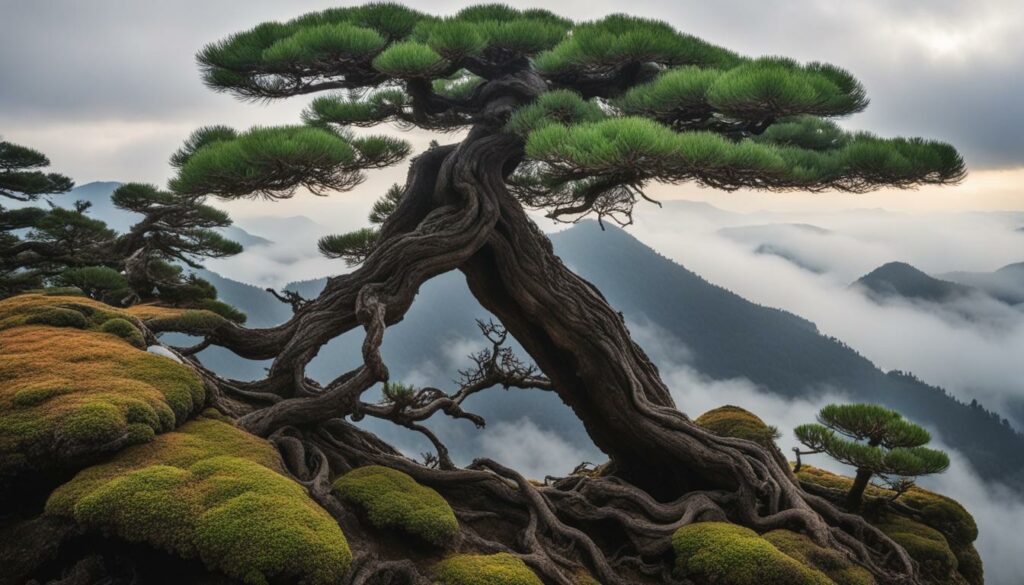
Each species has unique characteristics that cater to different aesthetic preferences and care abilities. The table below offers a comparison of care requirements for these hardy outdoor bonsai species, helping you choose the right tree for your garden environment.
| Species | Watering Needs | Sunlight Requirements | Climate Adaptability | Pruning Season |
|---|---|---|---|---|
| Pine Bonsai | Consistent moisture, avoid waterlogging | Full to partial sun | Cold-hardy, can handle frost | Late winter to early spring |
| Juniper Bonsai | Allow topsoil to dry between watering | Full sun | Tolerates a wide range, prefers drier climates | Spring to summer, with light trimming in autumn |
| Maple Bonsai | Evenly moist soil, more frequent watering in heat | Partial shade to protect leaves | Temperate climates, needs protection from extreme cold | Early spring before sap flow increases |
Whether you’re drawn to the enduring presence of the pine, the sculptural potential of the juniper, or the vivid palette of the maple, cultivating these hardy bonsai trees can be a rewarding experience. With careful attention to their needs and respect for their natural habits, you can develop a thriving outdoor bonsai collection that enhances your garden’s allure.
The Art of Outdoor Bonsai: Cultivation and Care
When it comes to mastering the art of garden bonsai, understanding the fundamentals of cultivation and care can make all the difference. As a gardener, your interest in hardy bonsai trees is more than just a pastime; it’s a dedication to creating living sculptures that demand precise attention to detail. Here, we explore the essential practices that will keep your bonsai flourishing in the outdoor environment.
For enthusiasts and collectors alike, the key to a thriving garden bonsai lies in the soil composition—it’s not just about dirt; it’s about creating a foundation that allows for excellent drainage while still retaining the necessary nutrients. The balance of watering cannot be overstated. Too much water and your bonsai’s roots will rot; too little, and the tree will dehydrate. Light, as well, is a vital factor, where the aim should be to emulate the natural conditions of the tree’s origin.
Below, we provide a helpful guide on some of the best practices for soil, watering, and lighting:
- Soil Composition: Aim for a well-draining mixture that allows for oxygen circulation. Substrates like akadama, pumice, and lava rock are commonly used in bonsai-specific soils.
- Watering: Understand the needs of your specific bonsai species. Overwatering is a common mistake; ensure the soil surface is slightly dry before watering deeply.
- Light Requirements: Though species vary, most hardy bonsai trees require substantial indirect sunlight to reproduce the environment of a forest canopy.
To ensure the well-being of your garden bonsai, regular observation and maintenance are indispensable. Keep a watchful eye for signs of over or underwatering, and adjust your care accordingly. In time, these efforts will result in a hardy, vibrant bonsai that enhances your outdoor space with its miniature grandeur.
Maximizing Growth: Fertilization and Watering Tips
To ensure your Bonsai Tree Species Outdoor or garden bonsai reaches its full potential, a solid grasp of fertilization and watering practices is indispensable. The right balance of nutrients and moisture can significantly enhance the vigor and aesthetics of your bonsai. Let’s delve into how to create the optimal nourishment routine for these living sculptures.
Understanding Fertilization Schedules
Fertilization isn’t merely about the act itself but also when and how often to do it. The life cycle of your bonsai dictates its nutritional needs, which vary with the changing seasons. Springtime calls for a higher nitrogen content to support vigorous growth, while during the summer, a balanced blend promotes overall health. Approaching fall, a lower nitrogen mix helps to prepare the bonsai for the dormancy of winter.
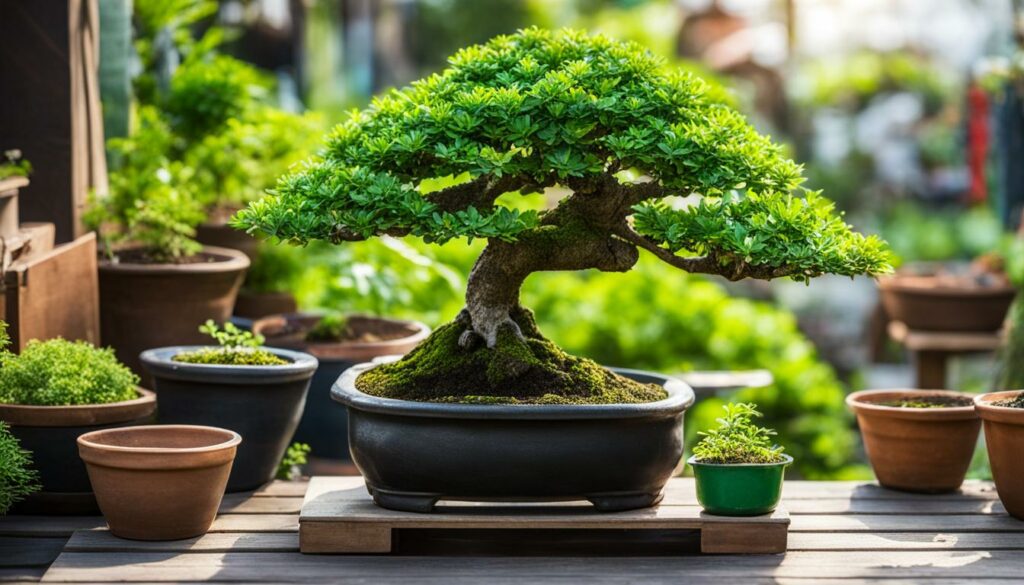
| Season | Recommended Fertilizer Type | Fertilization Frequency |
|---|---|---|
| Spring | High Nitrogen | Every 2 Weeks |
| Summer | Balanced (NPK: 10-10-10) | Monthly |
| Fall | Low Nitrogen | Every 4 to 6 Weeks |
| Winter | None or Low Phosphorus | Discontinue or Every 6 to 8 Weeks for Warm Climates |
Watering Techniques for Optimal Health
Proper watering does more than quench a plant’s thirst; it can drastically influence the health and development of your bonsai. Irrigation should be thorough, allowing water to freely flow from the drainage holes. Mindful of the unique requirements of Bonsai Tree Species Outdoor and garden bonsai, you’ll find that some species need more frequent watering than others, and environmental factors like humidity and temperature also play pivotal roles.
- Observe the soil: Water when the topsoil feels slightly dry to the touch.
- Seasonal adjustments: Increase watering in hot seasons or reduce during cooler months.
- Method: Use a watering can with a fine nozzle to avoid soil erosion and water evenly until it drains out the bottom.
Remember, the goal is to foster a conducive environment for growth, striking the right balance between nutrients and hydration to bring out the innate beauty of your bonsai.
Pruning Strategies for Outdoor Bonsai Species
Mastering the art of bonsai begins with understanding the critical role of pruning. Whether you’re nurturing an outdoor bonsai species or fostering hardy bonsai trees, the finesse with which you prune can dramatically impact the vitality and silhouette of your living sculpture. Let’s delve into the when, how, and tools vital for sculpting your bonsai.
When and How to Prune for Shape and Health
Pruning isn’t just about creating a pleasing aesthetic; it’s also essential for the health of your bonsai. Spring and summer are pivotal seasons for pruning outdoor bonsai species, as they respond best to shaping during periods of active growth. Strategic pruning helps to direct growth, maintain size, and enhance the tree’s natural form.
Prune your bonsai with the future in mind, anticipating how each cut will influence new growth and contribute to your tree’s long-term design.
Commence with removing any dead or diseased branches to preserve the tree’s health. Following that, prune for shape by trimming back new shoots to the first two or three leaves, especially in denser areas where light may struggle to penetrate.
Tools and Techniques for Precision
When it comes to pruning outdoor bonsai species, precision is key. Employ bonsai scissors for fine trimming and concave cutters to remove larger branches, creating a smooth wound that heals nicely over time.
| Tool | Use | Benefit |
|---|---|---|
| Bonsai Scissors | Trimming small shoots and leaves | Enables detail work with minimal damage |
| Concave Cutters | Removing thicker branches | Leaves a concave cut that heals with less scarring |
| Knob Cutters | Extracting knobs or undesired bulges | Creates a smooth surface to enhance the tree’s appearance |
Remember, the right technique is just as important as the right tool. Make your cuts at an angle to promote quick healing, and avoid pruning more than one-third of the foliage at any given time to maintain the tree’s energy balance.
Training Outdoor Bonsai Trees for Aesthetic Appeal
The artful practice of training garden bonsai transforms these miniature trees into living sculptures, each with its own unique form and beauty. When you begin shaping your hardy bonsai trees, you’re entering a tradition that has delighted and challenged gardeners for centuries. The techniques of wiring, pruning, and trunk manipulation are not just about aesthetics; they also encourage healthy growth and tree longevity.
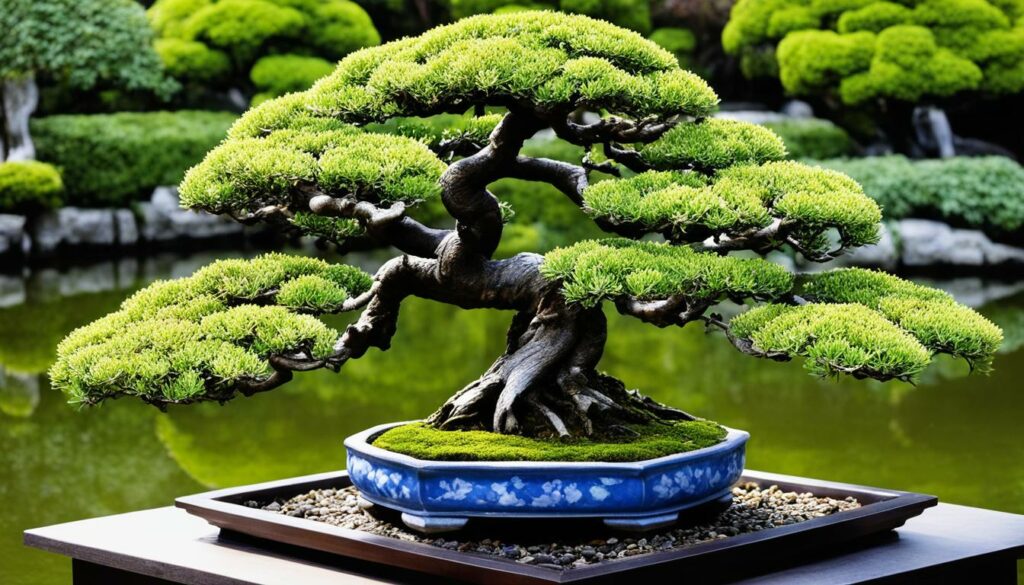
At the heart of this training lies the technique of wiring, which allows you to direct the growth and form of the tree’s branches and trunk. The wire can be applied to both young shoots and more mature branches, gently bending them into the desired shape and then holding them in place as they grow firm. It’s a subtle art—too much pressure and you can harm the tree, too little and the branch won’t hold the new form.
“Training a bonsai is much like painting a picture. You’re not just growing a tree; you’re sculpting a living work of art, one that changes with the seasons and grows with time.” — Graham Potter, Kaizen Bonsai
| Technique | Objective | Benefits |
|---|---|---|
| Wiring | To guide branch and trunk growth directionally | Encourages desired aesthetic forms; facilitates even growth |
| Branching | To develop a visually balanced and proportionate canopy | Supports the creation of traditional bonsai silhouettes |
| Trunk Shaping | To influence the tree’s overall structure and stability | Builds a strong foundation for the tree’s lifetime |
Branching is another critical aspect of bonsai training. It involves the selective pruning of branches to not only improve the tree’s shape but also to ensure that light and air can reach the inner foliage. This creates a balanced, harmonious tree that’s as healthy as it is beautiful. Similarly, trunk shaping sets the stage for the tree’s ultimate form, whether you’re aiming for a graceful curve or a powerful, rugged appearance that suggests age and resilience.
As you embark on training your garden bonsai, remember that patience and observation are your greatest tools. Each cut or bend is a deliberate decision in the long-term development of a hardy bonsai tree that will stand as a testament to both nature’s beauty and your gardening skill.
Winterizing Your Outdoor Bonsai: Protection from the Cold
As temperatures begin to drop, it’s essential to consider the specific needs of your Bonsai Tree Species Outdoor to ensure they remain vigorous through the colder months. Understanding the nuances of winter care for these hardy bonsai trees can be the key to their survival and longevity.
Insulating Roots and Preparing Soil
Preparation for winter begins at the roots. Your outdoor bonsai’s root system is its life support, especially during the freeze. To protect these delicate structures, consider mulching with straw or bark to provide a natural insulation layer. Adjusting your soil composition with more sand can also prevent water retention that leads to freezing root damage.
According to the Arbor Day Foundation, well-draining soil diminishes the risk of ice formation around the roots, which can be fatal to bonsai trees in winter.
Temporary Shelter Methods to Consider
While hardy bonsai trees are resilient, extreme weather can be challenging to manage. Creating a temporary shelter, such as a cold frame or an unheated greenhouse, offers an extra layer of protection. A simple structure with a transparent cover allows for sunlight penetration while safeguarding your bonsai from harsh conditions like wind, snow, and ice.
Remember that winter care varies depending upon the species of bonsai and your climate. It is not enough to cover or move them indoors; they must continue to receive adequate light and moisture. Monitor your bonsai during the winter months to ensure they are not in distress, adjusting your care techniques as needed to help them emerge in the spring healthy and strong.
With the right preparation, your bonsai can not only survive but thrive after the winter season.
Repotting and Root Care for Longevity
As an enthusiast looking to elevate your garden bonsai collection, understanding the intricacies of repotting is crucial for the sustained health and beauty of your outdoor bonsai species. It’s not just a routine task – it is a vital process that ensures the longevity of your miniature trees.
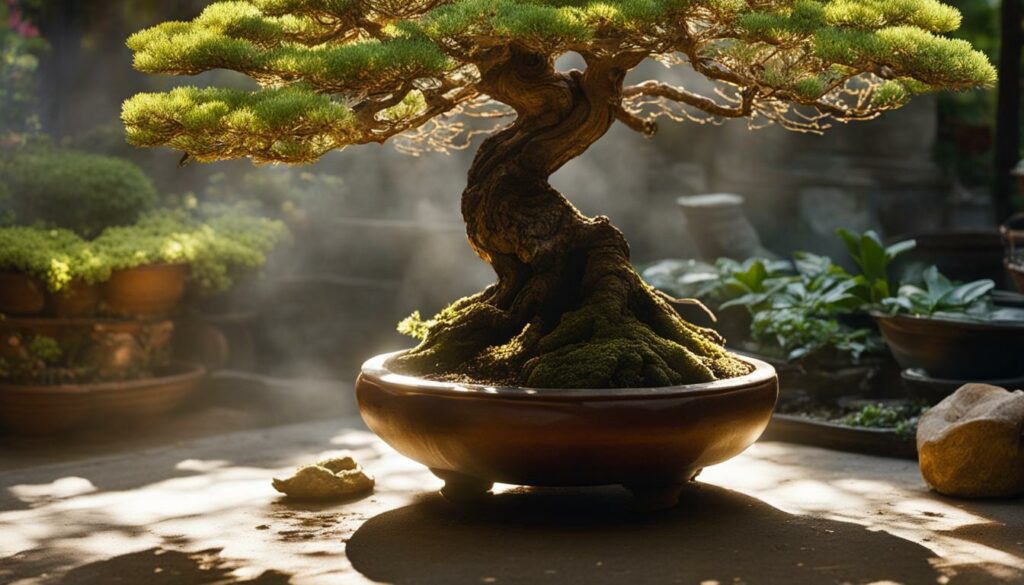
Timing for Repotting Outdoor Bonsai
The timing of repotting can significantly influence the well-being of your bonsai. Generally, the best moment to repot is just as the tree begins to emerge from its dormant winter state, showcasing signs of new growth. The frequency of this task varies among species and is also dependent on the age and size of your bonsai.
Root Pruning Without Harming Your Tree
Root pruning is a delicate art. When done correctly, it encourages healthier, more fibrous root growth. However, it is imperative to prune the roots without causing undue stress to your bonsai tree. With attention to detail and the right technique, you can promote a robust and compact root system.
| Species | Signs it’s Time to Repot | Recommended Repotting Interval | Season for Repotting |
|---|---|---|---|
| Pine Bonsai | Roots circling the container | 3-5 years | Early spring |
| Juniper Bonsai | Water retention decreases | 4-6 years | Late winter to early spring |
| Maple Bonsai | Slowed growth | 2-3 years | Spring before leaf growth |
By following these guidelines, you’re not just repotting your bonsai; you’re giving it a fresh platform to thrive. Remember that every action you take towards the care of your outdoor bonsai species has a significant impact on its longevity, making every effort in garden bonsai cultivation a rewarding journey.
Pests and Diseases: Prevention and Treatment
Maintaining the health of your garden bonsai and hardy bonsai trees is paramount to ensure their longevity and aesthetic appeal. In this section, we delve into the crucial aspects of preventing and treating the common pests and diseases that threaten these miniature landscapes.
Outdoor bonsai species are susceptible to a variety of pests and diseases that can compromise their health. Vigilant monitoring and early detection are key to protecting your bonsai from serious damage.
Preventive Measures: To safeguard your bonsai, consider these proactive strategies:
- Regular inspection of leaves and branches for signs of infestation or disease.
- Maintaining cleanliness around the bonsai to prevent the buildup of harmful pathogens.
- Isolating new plants before introducing them to your garden to prevent the spread of potential pests or diseases.
When prevention is not enough, and you notice telltale signs of distress, it’s important to act swiftly to mitigate the issues.
| Common Pests | Organic Treatments | Chemical Treatments |
|---|---|---|
| Spider Mites | Neem oil, insecticidal soap | Acaricides |
| Aphids | Ladybugs, horticultural oils | Systemic insecticides |
| Scale Insects | Alcohol rubs, water jets | Oil-based pesticides |
| Fungal Diseases | Copper fungicides, sulfur sprays | Synthetic fungicides |
Implement these measures as soon as you detect problems to prevent further damage. Remember that the goal is to manage and rectify issues with minimal harm to the tree and the environment.
According to the Integrated Pest Management program at the University of California, understanding a pest’s life cycle and habits is crucial in developing an effective management strategy.
By combining preventive measures with targeted treatment, you can successfully manage pests and diseases in your bonsai garden, keeping your garden bonsai and hardy bonsai trees vibrant and thriving for years to come.
Creating a Harmonious Bonsai Display in Your Garden
Intertwining the ancient tradition of bonsai with the lush greenery of your garden can transform your outdoor space into a serene escape. Whether you’re a seasoned bonsai cultivator or a budding enthusiast, the integration of these miniature trees with your outdoor milieu should be approached with a thoughtful consideration for design. By following key principles of bonsai arrangement, you can ensure that each Outdoor bonsai species becomes a cohesive part of your garden’s narrative.
Design Principles for Bonsai Arrangement
As you begin placing your Bonsai Tree Species Outdoor, consider the fundamental principles of design which include balance, proportion, and unity. Strive for a naturalistic setting that doesn’t overwhelm the senses but rather invites a journey of visual exploration. Balance is achieved not by symmetry, but through the visual weight of elements, ensuring that no single bonsai dominates the view. Proportion is critical as well; these trees should scale with their surroundings to create a sense of depth and space. Lastly, unity is essential in tying your garden’s thematic elements with the character of each bonsai, cultivating a seamless visual experience.
Complementing Your Garden’s Existing Aesthetics
Your garden’s already established style offers a canvas on which to showcase your outdoor bonsai species. Consider the textures, colors, and shapes present in your environment. A flowering Azalea bonsai, for instance, can echo the blooms of a nearby flowerbed, while the rigid form of a Juniper bonsai might resonate with architectural features. Evaluate seasonal changes too – deciduous bonsai varieties bring dynamic transformation through the seasons, complementing your garden’s evolving appearance. By considering these aspects, your bonsai will not stand apart but rather enhance and celebrate the existing beauty of your personal green haven.
FAQ
What makes outdoor bonsai species different from indoor bonsai species?
Outdoor bonsai species are typically trees that can withstand the varying conditions of outdoor climates, including seasonal changes in temperature and exposure to the elements. Unlike indoor bonsai, which are often more tropical and require stable indoor climates, outdoor bonsai consist of hardy species like pines, junipers, and maples that can be incorporated into a garden setting and go through natural dormancy cycles.
Are there specific bonsai trees recommended for outdoor garden settings?
Yes, there are many species well-suited for garden bonsai cultivation, but some of the most popular and hardy bonsai trees for outdoor settings include Pine Bonsai, Juniper Bonsai, and Maple Bonsai. These species are valued for their resilience to outdoor conditions and aesthetic versatility in a variety of garden styles.
How do I choose the right bonsai tree species for my outdoor environment?
Choosing the right outdoor bonsai species requires understanding your local climate, including the U.S. Department of Agriculture Plant Hardiness Zone. It’s important to select species that can tolerate the temperature extremes of your area. Local bonsai clubs and nurseries can be valuable resources for advice on regionally appropriate species.
What are the sun and exposure requirements for outdoor bonsai trees?
Most outdoor bonsai trees require several hours of direct sunlight each day, but the specific needs can vary by species. Assessing the sunlight in your garden and choosing a location that meets your bonsai’s requirements are vital steps in providing the right conditions for healthy growth.
How do I protect my outdoor bonsai from extreme winter temperatures?
Protecting outdoor bonsai in winter can involve various methods, such as mulching or burying the pot in the ground to insulate roots, adjusting watering schedules to prevent freezing, and potentially providing a cold frame or other temporary shelter to shield the trees from the severest conditions. Each species may have different requirements for winter protection.
When should I repot my outdoor bonsai tree, and why is it important?
Repotting is typically done every two to five years, depending on the species and growth rate of your bonsai. The best time to repot is usually in early spring, before the onset of vigorous growth. Repotting is crucial for maintaining the health of the tree, refreshing the soil, and managing root growth.
What are some common pests and diseases that can affect outdoor bonsai trees, and how can I treat them?
Common pests can include aphids, spider mites, and scale insects, while diseases may involve fungal issues like root rot. Treatment often starts with good cultural practices, like proper watering and air circulation. Organic methods, such as neem oil, can treat many pests and diseases. In severe cases, chemical treatments may be necessary, always following the manufacturer’s instructions and considering the scale and nature of the infestation or disease.
How can I integrate bonsai trees into my garden design to create a harmonious landscape?
To integrate bonsai trees into your garden harmoniously, consider the design principles of balance, proportion, and unity. Positioning bonsai within view of seating areas or paths can create focal points, while ensuring the style and scale of the bonsai complement the overall garden aesthetic. Additionally, the use of ground cover, companion plants, or stones can enhance the visual connection between the bonsai and its surroundings.
